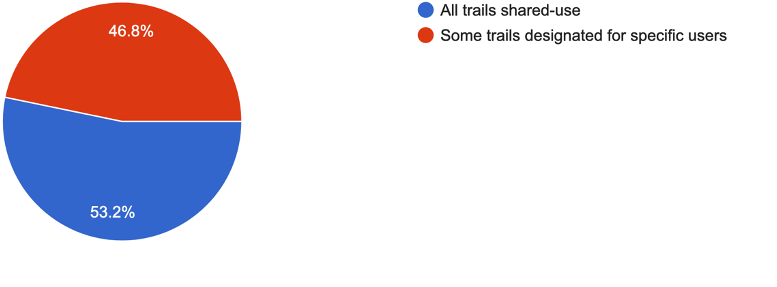Thanks to everyone who took the time to complete our recent trail survey for Rio Vista! Your voice is important to ensuring that the diverse interests of park stakeholders are heard.
The survey gathered input on the changes proposed in the June 2023 trail plan, which was produced by the City of Tucson Department of Parks and Recreation and their consultants. These proposed changes will have consequences for the park’s visitors, plants, and animals for at least a generation.
We had a strong response to the survey: nearly one-third of those we queried (79 of 270) completed it. Although the survey captured a range of perspectives, the responses we received clearly show that stakeholders are devoted to protecting the park’s ecological values and to supporting the connection of human communities with nature.
Summary of Results
Here’s a quick overview of the survey results. For more information, download our full report, which describes our methodology and presents stakeholder comments.
How often, on average, do you visit the natural area of the park? Most respondents (more than 60%) visit the park at least 2 days per week.

How do you use the natural area of the park? Hiking/walking, birding, and dog walking were reported as the most common uses of the park’s natural area. Note that respondents were also given the option of entering custom answers for this question.

How far do you live from the park? Nearly all respondents reported that they live within 5 miles of the park. More than 73% live within 1 mile.

Do you think that trails should have spatial options for visitors (pedestrians, equestrians, cyclists) to pass each other safely? Examples: adequate trail width, alternate parallel paths for heavily used trail segments, pull-offs or lay-bys at tight spots. The majority (74%) of respondents favor implementing options for safe passing.

Do you think that all trails should be for shared use of all visitors, or do you favor designating some trails as equestrian only or pedestrian only? Respondents were split nearly evenly on whether some trails should be designated for specific users.

Do you support establishing a birding/wildlife-viewing loop that uses existing trails but adds short spurs to a few viewing locations in the most diverse habitats? A large majority (88%) of respondents support adding birding/wildlife-viewing options to existing trails.

Do you support establishing an interpretive trail that follows existing paths but adds signage and other educational elements, in the developed area of the park (west side)? A large majority (83%) of respondents support adding interpretive elements to the west (developed) area of the park.

Do you think that Tucson Parks and Recreation vehicles should be restricted to the diagonal ADA path and the primary east–west trails from the middle and northern Cactus Boulevard entrances, when they are driven through the natural area for park maintenance? A large majority (88%) of respondents support restricting routes for Tucson Parks and Recreation vehicles

Do you think that trails should be named or numbered for easier wayfinding? Respondents were split on this issue; a slight majority favors no naming or numbering.

Do you think that Tucson Parks and Recreation should use glyphosate (Roundup) or other synthetic herbicides to control invasive plants in the park? (Note: Rio Vista was designated a pilot site for Organic First Tucson.) An overwhelming majority (92%) of respondents oppose the use of synthetic herbicides in the park.

Recommendations
Based on the survey results, we respectfully recommend the following to Tucson Parks and Recreation in revising the current draft of the trail plan:
- Take into account the diverse groups of visitors and stakeholders. Trail layout, design, and construction that accommodate their needs and behavior will encourage appropriate use of paths and will reduce damage to natural assets. Naturalists (especially birders) and equestrians are two important user groups whose concerns have not been adequately addressed in the current draft.
- Build in spatial options for visitors to pass each safely. Appropriate trail width, alternate parallel paths for heavily used trail segments, and pull-offs or lay-bys at tight spots all are possibilities.
- Adopt the birding/wildlife-viewing and interpretive trail loops proposed by Tucson Audubon Society and other conservationists. These will support the dual purpose of a natural resource park and are strongly favored by stakeholders.
- Restrict access of Tucson Parks and Recreation vehicles to the diagonal ADA path and the primary east–west trails from Cactus Boulevard to the westside developed area. Other trails in the park are not appropriate for trucks and other heavy vehicles.
- Seek alternatives to glyphosate and other synthetic herbicides to control invasive plants in the park. In 2019, Rio Vista was designated a pilot site for Organic First Tucson. At that time, Tucson Parks and Recreation made a commitment to stakeholders not to use these synthetic products in Rio Vista. Regardless of the current status of the Organic First Tucson program, nearly all stakeholder respondents are counting on the city to uphold this agreement. Their concerns are for the safety of both the human and the wild communities of the park.
